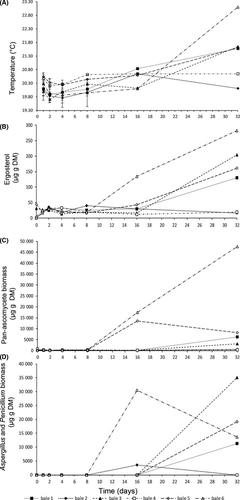当前位置:
X-MOL 学术
›
Microb. Biotechnol.
›
论文详情
Our official English website, www.x-mol.net, welcomes your
feedback! (Note: you will need to create a separate account there.)
Application of monoclonal antibodies in quantifying fungal growth dynamics during aerobic spoilage of silage.
Microbial Biotechnology ( IF 4.8 ) Pub Date : 2020-03-10 , DOI: 10.1111/1751-7915.13552 Kate Le Cocq 1 , Bethany Brown 1 , Christopher J Hodgson 1 , Jamie McFadzean 1 , Claire A Horrocks 1 , Michael R F Lee 1, 2 , David R Davies 1, 3
Microbial Biotechnology ( IF 4.8 ) Pub Date : 2020-03-10 , DOI: 10.1111/1751-7915.13552 Kate Le Cocq 1 , Bethany Brown 1 , Christopher J Hodgson 1 , Jamie McFadzean 1 , Claire A Horrocks 1 , Michael R F Lee 1, 2 , David R Davies 1, 3
Affiliation

|
Proliferation of filamentous fungi following ingress of oxygen to silage is an important cause of dry matter losses, resulting in significant waste. In addition, the production of mycotoxins by some filamentous fungi poses a risk to animal health through mycotoxicosis. Quantitative assessment of fungal growth in silage, through measurement of ergosterol content, colony‐forming units or temperature increase is limiting in representing fungal growth dynamics during aerobic spoilage due to being deficient in either representing fungal biomass or being able to identify specific genera. Here, we conducted a controlled environment aerobic exposure experiment to test the efficacy of a monoclonal antibody‐based enzyme‐linked immunosorbent assay (ELISA) to detect the proliferation of fungal biomass in six silage samples. We compared this to temperature which has been traditionally deployed in such experiments and on‐farm to detect aerobic deterioration. In addition, we quantified ergosterol, a second marker of fungal biomass. After 8 days post‐aerobic exposure, the ergosterol and ELISA methods indicated an increase in fungal biomass in one of the samples with a temperature increase observed after 16 days. A comparison of the methods with Pearson's correlation coefficient showed a positive association between temperature and ergosterol and both markers of fungal biomass. This work indicates that the technology has potential to be used as an indicator of microbial degradation in preserved forage. Consequently, if it developed as an on‐farm technique, this could inform forage management decisions made by farmers, with the goal of decreasing dry matter losses, improving resource and nutrient efficiency and reducing risks to animal health.
中文翻译:

单克隆抗体在量化青贮饲料有氧腐败过程中真菌生长动态中的应用。
青贮饲料中氧气进入后丝状真菌的增殖是干物质损失的一个重要原因,导致大量浪费。此外,一些丝状真菌产生的霉菌毒素通过霉菌中毒对动物健康构成风险。通过测量麦角甾醇含量、菌落形成单位或温度升高来定量评估青贮饲料中的真菌生长,由于缺乏代表真菌生物量或识别特定属的能力,因此在有氧腐败期间的真菌生长动态方面受到限制。在这里,我们进行了受控环境有氧暴露实验,以测试基于单克隆抗体的酶联免疫吸附测定(ELISA)检测六个青贮饲料样品中真菌生物质增殖的功效。我们将其与传统上在此类实验和农场中使用的温度进行比较,以检测有氧恶化。此外,我们还定量了麦角甾醇,这是真菌生物量的第二个标志物。有氧暴露 8 天后,麦角甾醇和 ELISA 方法表明其中一份样品中真菌生物量增加,16 天后观察到温度升高。将这些方法与皮尔逊相关系数进行比较表明,温度和麦角甾醇以及真菌生物量的两个标记之间呈正相关。这项工作表明该技术有潜力用作保存饲料中微生物降解的指标。因此,如果它作为一种农场技术发展起来,可以为农民做出的饲料管理决策提供信息,从而减少干物质损失,提高资源和养分效率,并降低动物健康风险。
更新日期:2020-03-10
中文翻译:

单克隆抗体在量化青贮饲料有氧腐败过程中真菌生长动态中的应用。
青贮饲料中氧气进入后丝状真菌的增殖是干物质损失的一个重要原因,导致大量浪费。此外,一些丝状真菌产生的霉菌毒素通过霉菌中毒对动物健康构成风险。通过测量麦角甾醇含量、菌落形成单位或温度升高来定量评估青贮饲料中的真菌生长,由于缺乏代表真菌生物量或识别特定属的能力,因此在有氧腐败期间的真菌生长动态方面受到限制。在这里,我们进行了受控环境有氧暴露实验,以测试基于单克隆抗体的酶联免疫吸附测定(ELISA)检测六个青贮饲料样品中真菌生物质增殖的功效。我们将其与传统上在此类实验和农场中使用的温度进行比较,以检测有氧恶化。此外,我们还定量了麦角甾醇,这是真菌生物量的第二个标志物。有氧暴露 8 天后,麦角甾醇和 ELISA 方法表明其中一份样品中真菌生物量增加,16 天后观察到温度升高。将这些方法与皮尔逊相关系数进行比较表明,温度和麦角甾醇以及真菌生物量的两个标记之间呈正相关。这项工作表明该技术有潜力用作保存饲料中微生物降解的指标。因此,如果它作为一种农场技术发展起来,可以为农民做出的饲料管理决策提供信息,从而减少干物质损失,提高资源和养分效率,并降低动物健康风险。











































 京公网安备 11010802027423号
京公网安备 11010802027423号